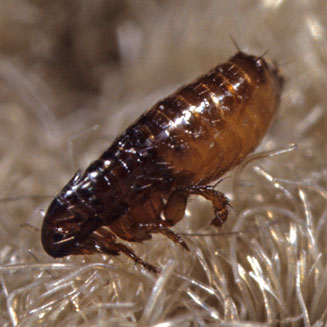|
Ctenocephalides felis (Cat Flea)
Life
> Eukaryotes >
Opisthokonta >
Metazoa (animals) > Bilateria > Ecdysozoa
> Panarthropoda > Tritocerebra > Phylum:
Arthopoda > Mandibulata >
Atelocerata > Panhexapoda >
Hexapoda
> Insecta (insects) > Dicondyla > Pterygota >
Metapterygota > Neoptera > Eumetabola > Holometabola > Panorpida > Antliophora
> Mecoptera > Siphonaptera
(fleas) > Pulicidae
 |
|
|
A cat flea Ctenocephalides felis waits on the carpet for a passing cat, dog or
human.
[photo H.G. Robertson ©] |
|
Distribution and habitat
Possibly originally native to Egypt and associated regions as this species was
first described from a specimen collected in Egypt. Now found throughout the
world where the adult is a external blood parasite of rats, cats and dogs.
Life cycle
- The eggs of cat fleas are oval, white and large in relation to
the size of the adult (c. 0.5 mm long). They are laid in the fur of the dog
or cat and can easily end up on the floor when the animal scratches or
shakes itself.
- The worm-like larvae live in crevices of floors, in and under
carpets, but most commonly they are found in the cat or dog's bedding. They
feed on organic matter such as flea faeces and dry blood. The blood usually
originates from the adults who squirt it from their anuses while feeding on
the host. This explains why a flea in your bed will leave flecks of blood on
the sheets.
- At the end of its development, the larva constructs a silken cocoon
within which it moults into a pupa. In the pupal stage of insects,
the genes 'turn on' the production of a new set of cells that will form the
adult. Most of the old larval cells are broken down.
- In cat fleas, the adult does not normally emerge from the pupa as
soon as it is fully developed but waits until it senses the presence of a
host. The main stimulus for emergence is the vibration caused by the host's
footsteps. This quiescent stage can be as long as 200 days and explains why
people entering deserted houses can suddenly find themselves covered in
fleas. In the time that the house has been deserted, the larvae have all
pupated, only to emerge when they sense the entry of the unsuspecting
person.
Hosts
Of the nearly 100 species of flea found in southern Africa, the cat flea, Ctenocephalides
felis, is usually the species responsible for causing human discomfort. Its favourite
hosts are rats, cats and dogs, although it will also feed on humans, given half a chance.
Your dog is more likely to have cat fleas than the rarer dog fleas, Ctenocephalides
canis.
Some women complain bitterly that fleas seem to be particularly fond of them.
A woman in bed with a man
sometimes find herself covered in bites after a night's sleep, while her partner
is
unscathed. The reason for this seems to be that fleas respond to female hormone levels.
For instance, the rabbit flea has been found to coordinate its life cycle with that of the
mother rabbit by sensing and responding to her hormones.
Parasites
The cat flea is an
intermediate host of the dog tapeworm, Dipylidium caninum.
Importance
- Bites cause irritation and allergic reactions.
- You can become infected by the Dog tapeworm (see above) if you
accidentally swallow a flea.
Control of fleas
So, now that you know the life cycle of the flea, the way to stop fleas from becoming a
serious problem in your home is readily apparent. Don't let your cats and dogs sleep in
bedrooms and preferably make them sleep outside. Vacuum the floors and carpets regularly.
Clean your pets' bedding frequently, as it is here that most of the flea larvae will be
found. Dogs need to be washed fairly often (ask your vet for details), particularly the
older individuals who tend not to clean themselves thoroughly. There are a number of
insecticidal formulations for controlling fleas on your pets and, once again it is best to
ask your vet for advice. If fleas in your house get totally out of control, it might be
necessary to fumigate certain rooms.
Links
Publications
-
Picker M, Griffiths C. 2011. Alien and invasive animals - a
South African perspective. Struik Nature, Cape Town.
-
Rust, M.K. & Dryden, M.W. 1997. The biology, ecology,
and management of the cat flea. Annual Review of Entomology 42:
451-473.
Text by Hamish G. Robertson, Iziko © |
